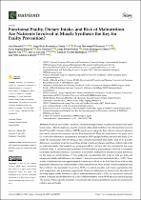Por favor, use este identificador para citar o enlazar este ítem:
https://repositorio.usj.es/handle/123456789/701
| Título : | Functional Frailty, Dietary Intake, and Risk of Malnutrition. Are Nutrients Involved in Muscle Synthesis the Key for Frailty Prevention? |
| Autor: | Moradell, Ana


Fernández-García, Ángel Iván 
Navarrete-Villanueva, David 
Sagarra-Romero, Lucía 

Gesteiro, Eva 


Pérez-Gómez, Jorge 


Rodríguez-Gómez, Irene 

Ara, Ignacio 
Casajus, José Antonio 


Vicente-Rodríguez, Germán 


Gómez-Cabello, Alba 

|
| Palabras clave : | Performance; Frailty; Nutritional status; Vitamin D; Protein |
| Fecha de publicación: | 8-abr-2021 |
| Editorial : | MDPI |
| Citación : | Moradell, A.; Fernández-García, Á.I.; Navarrete-Villanueva, D.; Sagarra-Romero, L.; Gesteiro, E.; Pérez-Gómez, J.; Rodríguez-Gómez, I.; Ara, I.; Casajús, J.A.; Vicente-Rodríguez, G.; et al. Functional Frailty, Dietary Intake, and Risk of Malnutrition. Are Nutrients Involved in Muscle Synthesis the Key for Frailty Prevention?. Nutrients 2021, 13, 1231. https://doi.org/10.3390/ nu13041231 |
| Resumen : | Frailty is a reversible condition, which is strongly related to physical function and nutritional status. Different scales are used to screened older adults and their risk of being frail, however, Short Physical Performance Battery (SPPB) may be more adequate than others to measure physical function in exercise interventions and has been less studied. Thus, the main aims of our study were: (1) to describe differences in nutritional intakes by SPPB groups (robust, pre-frail and frail); (2) to study the relationship between being at risk of malnourishment and frailty; and (3) to describe differences in nutrient intake between those at risk of malnourishment and those without risk in the no-frail individuals. One hundred one participants (80.4 ± 6.0 year old) were included in this cross-sectional study. A validated semi-quantitative food frequency questionnaire was used to determine food intake and Mini Nutritional Assessment to determine malnutrition. Results revealed differences for the intake of carbohydrates, n-3 fatty acids (n3), and saturated fatty acids for frail, pre-frail, and robust individuals and differences in vitamin D intake between frail and robust (all p < 0.05). Those at risk of malnutrition were approximately 8 times more likely to be frail than those with no risk. Significant differences in nutrient intake were found between those at risk of malnourishment and those without risk, specifically in: protein, PUFA n-3, retinol, ascorbic acid, niacin equivalents, folic acid, magnesium, and potassium, respectively. Moreover, differences in alcohol were also observed showing higher intake for those at risk of malnourishment (all p < 0.05). In conclusion, nutrients related to muscle metabolism showed to have different intakes across SPPB physical function groups. The intake of these specific nutrients related with risk of malnourishment need to be promoted in order to prevent frailty. |
| URI : | https://repositorio.usj.es/handle/123456789/701 |
| ISSN : | 2072-6643 |
| Aparece en las colecciones: | Artículos de revistas |
Ficheros en este ítem:
| Fichero | Descripción | Tamaño | Formato | |
|---|---|---|---|---|
| Functional frailty, dietary intake, and risk of malnutrition. Are nutrients involved in muscle synthesis the key for frailty prevention.pdf | 1,56 MB | Adobe PDF |  Visualizar/Abrir |
Este ítem está sujeto a una licencia Creative Commons Licencia Creative Commons

